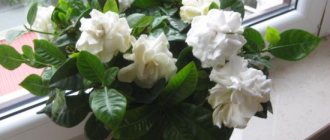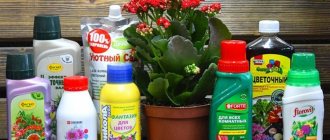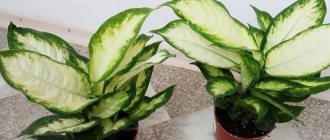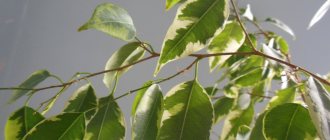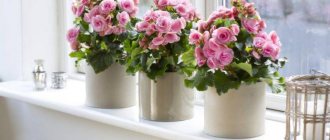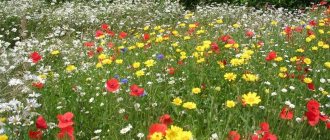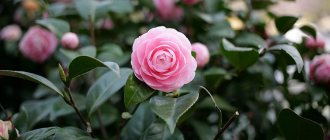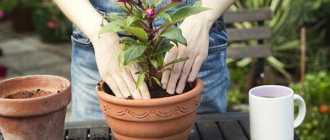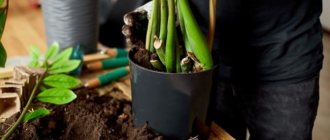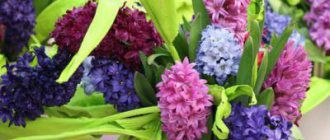A huge number of flowers are grown at home, and there are hundreds of indoor plants just starting with the letter “D”. Among them there are palm trees and ferns growing in the tropics or on islands. The most popular and easy to care for, but at the same time spectacular are dizygotheca, dracaena, dieffenbachia and lesser-known, but also very decorative davallia, drimiopsis, didymohlena, dionaea. Anyone can create a green corner at home by choosing to grow one or more species of these extraordinary plants.
Delightful dizygoteca
Dizygotheca belongs to the genus Araliaceae. In the wild, dizygotheca grows in Australia and on the islands of Oceania, where it is found in the form of an evergreen shrub. Its peculiarity is its beautiful decorative leaves. The flowers are discreet, collected in an umbrella and are hardly noticeable, but the shape of the jagged leaves cannot go unappreciated. In addition to the shape, the colors and shades of the leaves are interesting: these can be copper or charcoal shades.
A well-lit, sunny place is suitable for dizygoteca . Exposure to direct sunlight is not harmful to it, but still you should not leave it on the windowsill at noon in the summer. But in winter she will have to give up the sunniest window sill. If the room temperature exceeds 18 degrees, additional lighting is required. In summer, the flower can be taken out into the fresh air, but not under the burning rays.
For spring and summer, 20 degrees Celsius is enough for dizygoteke, in winter from 15 to 18 degrees. During the heating season, it is contraindicated to be located close to the heating system. It cannot tolerate dry air, so it must be constantly sprayed in winter.
In spring and summer, dizygoteca needs frequent watering, but drying out and stagnation of water in the pot should not be allowed. In autumn, the amount of watering is reduced, and in winter it is reduced to a minimum - the soil should not be allowed to dry out . Water for irrigation should be settled and at room temperature. Fertilizing should be applied in the summer; a special fertilizer for plants with decorative leaves is suitable.
Every year or two, the plant needs to be replanted. The soil should consist of 2 parts turf and 1 part humus and sand; drainage is required.
Game for 1st grade “Flower Alphabet”
Games to test your knowledge
Game for junior schoolchildren “Flower Alphabet”
Description of work : Game “Flower Alphabet”. The game "Chamomile" is designed for children 6-7 years old. It will be useful for educators, additional education teachers, and parents. Goal : Formation of communication skills, a sense of joy in collective gaming activities. Introduce children to the plants of the flower bed and teach them to distinguish them; cultivate a caring attitude towards nature. Objectives: - Develop communication skills, speech, memory, imagination, thinking; The teacher divides the children into two teams, then writes letters on the board. Children take turns saying the names of colors starting with these letters. The team that names the most colors wins. A: aster, pansy, amaryllis... B: cornflower, violet, loach... D: carnation, dahlia, gladiolus... K: cactus, calla lilies, water lily, crocus... L: lily of the valley, levkoy, lily, lotus, lion's call. M: poppy, magnolia, lungwort, daisy... N: narcissus, forget-me-not, marigold... P: peony, petunia, snowdrop, fern... R: rose, chamomile, mignonette... Game "Chamomile" There is a chamomile flower on the board. But on the back of the petals are written tasks that can be completed alone or as a team. The team with the most correct answers wins. Tasks on petals: 1. Name the summer flowers. 2. Name the autumn flowers. 3.Sing a song about flowers. 4.Name the wild flowers. 5.Name the spring flowers. 6.Name the garden flowers. 7.Guess riddles about flowers. A boy in a white T-shirt is walking along a snow-covered lawn. (Snowdrop.)
It blooms in the spring As soon as the forest snow melts away, And on each stem there are a row of light bulbs.
(Lily of the valley.)
Sometimes purple, sometimes blue, He met you at the edge of the forest.
It is endowed with a sonorous name, but we have never heard the ringing. (Bell.)
Head on a leg, There are peas in the head.
(Poppy)
It will be born in bread, but eating it is not good.
(Cornflower.)
In a clearing by the river The stems are proudly held, Like snow-white porcelain cups...
(daisies.)
If in the summer you find delicate flowers in the swamp, Don’t waste a minute - Contemplate...
(forget-me-nots.)
Cold.
All the gardens are empty. Well, what flowers are there? But in spite of the frost, in March they sell... (mimosa.) Everyone is familiar with us, Bright as flames. Admire the wild Scarlet... (carnations.)
We recommend watching:
Games for children's disco Games for spectators during school-wide events in elementary schools Intellectual game for younger schoolchildren with a presentation on the topic: Animals Games for grades 1-2 on the topic: Animals and plants
Similar articles:
Games for children in winter
Games for children with and on snow
Game program for elementary school
Outdoor games on the school playground in winter for children 7-8-9 years old
Games for elementary school
Graceful davallia
This perennial fern from the Davalliaceae family grows very quickly. It is called "squirrel's or hare's foot", another name is "deer's foot". Dawallia is found in Japan and China.
The plant's bright green, wedge-shaped leaves grow on golden stems, and its creeping roots are covered with dark hairs.
There are the following popular varieties of dawllia:
- dallalia vulgare;
- Canarian dawllia;
- dense dawllia.
Davallia loves warmth and light, but not direct sunlight, but natural diffused lighting. You can place the plant near a western or eastern window, because with a lack of light it slows down its growth. The air temperature in the room should be between 18-22 degrees; cold is contraindicated.
Davalia is very sensitive to lack of moisture, so when the top layer of soil dries out, you need to water the plant. In summer it is watered more often than in winter. When watering, do not use cold water and do not allow water to get on the roots located on the surface of the soil; you need to pour water into a pan or use a watering can with a narrow spout.
For dalliya, the air humidity in the room should be at least 50% . To make her feel comfortable, she needs to be periodically sprayed with settled water. The soil for planting the plant should be light peaty, mixed with sand. From June to August, the plant must be fed with fertilizer suitable for indoor plants every two weeks.
For propagation, layering is used - “hare's feet”. Small bushes grow on them, which can be used for replanting.
Names of flowers in alphabetical order from a to z
Flower names in alphabetical order by letter
- Abutilon, indoor maple, rope
- Agave
- Agapanthus, African or Nile lily
- Ageratum
- Aglaonema, another article about Aglaonema
- Agrostemma, cockle
- Adenium, Desert Rose
- Adiantum - fern
- Adonis
- Adromishus
- Azalea, rhododendron
- Azorella
- Calamus, acorus
- Aquilegia, catchment, orlik
- Wolfsbane, fighter, lumbago-grass
- Actinidia - liana
- Alyssum, alyssum
- Allamanda
- Alocasia
- Aloe, agave
- Althea
- Alpinia
- Alsobia
- Alstroemeria
- Amaranth
- Amaryllis
- Amorpha
- Amsonia
- Anemone, anemone
- Anigozanthos
- Antennaria, cat's paw
- Anthurium
- Pansies
- Aporocactus
- Aralia
- Araucaria
- Arbutus, strawberry
- Argyroderma
- Ardisia
- Areca, betel
- Arizema
- Thrift
- Arum
- Asparagus, asparagus
- Aspidistra, friendly family
- Asplenium, kostenets – fern
- Astilbe
- Astilboides
- Aster
- Aster annual, Callistephus
- Astrantia, star
- Astrophytum
- Aucuba, golden tree
- Aurinia, hiccup
- Aphelandra
- Achimenes
- What about the price
- Acidanthera, fragrant gladiolus
- Aerides - orchid
- Purple, roundleaf
- Ledum, ledum
- Badan, Bergenia
- Impatiens, impatiens, impatiens
- Bamboo
- Periwinkle, vinca
- Velvet, phellodendron
- Marigolds, tagetes. How to grow them
- Begonia
- Colchicum, Colchicum
- Butterbur
- Whiteflower
- Euonymus
- Euonymus, pseudolaurel
- Bertolonia
- Crazy cucumber, thorny liana
- Bilbergia
- Privet
- Blekhnum, derbyanka - fern
- Bobovnik
- Bovieya
- Beaucarneya, nolina
- Borage, borage, borage
- Brandushka, Bulbocodium
- Brachychiton
- Browallia
- Brunner, forget-me-not
- Brunfelsia
- Cowberry
- Bell, adenophora
- Bougainvillea
- Buddleya
- Budra, glekhoma
- Buzulnik, ligularia
- Initial letter, Betonika
- Valerian
- Waldsteinia
- Vanda - orchid
- cornflower
- Basilisk
- Vatochnik, asklepias, lastoven
- Watch, shamrock
- Washingtonia
- Weigela
- Loosestrife
- Verbena
- Heather
- Veronica
- Vesennik, erantis
- Vechernitsa
- Grape
- Vineyard, ampelopsis
- Cherry
- Volzhanka
- Wolfman, wolfberry, daphne
- sparrow
- Voronets, Akteya
- Vriesia, Vriesia
- Elm - bonsai
- Elm, elm, birch bark
- Bindweed, convolvulus
- Gaillardia
- Witch hazel
- Gardenia
- Gasteria
- Gatsania
- Carnation
- Heuchera
- Helenium
- Heliconia
- Heliotrope
- Helipterum
- Hemanthus
- Geogenanthus
- Dahlia
- Geranium
- Gerbera, "Transvaal daisy"
- Heteropanax
- Hyacinth
- Hymenocallis, Pancratium
- Gymnocalycium - cactus
- Ginkgo
- Ginura
- Hypocyrta
- Hypoestes
- Hippeastrum
- Gypsophila
- Gladiolus
- Gloriosa
- Godetia
- Gymnocarpium - fern
- Blueberry
- Gomphrena
- Highlander
- Gentian, gentiana
- Hydrangea, hydrangea
- Goryanka
- Avens
- Pomegranate
- Grevillea, silk oak
- Pear
- Lipstick, mimulus
- Guzmania, Guzmania
- Goose onion, gagea
- Davallia - fern
- Maiden grape, parthenocissus - liana
- Elecampane
- Deytsia
- Delphinium, spur
- Dendrobium - orchid
- Loosestrife
- Derain, svidina, cornus, dogwood
- Jeffersonia
- Dizygoteka
- Dixonia - fern
- Dimorphotheca
- Dipladenia, Mandevilla
- Dieffenbachia
- Di
- Doritenopsis - orchid
- Doronicum
- Dracaena
- Drimiopsis
- Gorse
- Drakvennik, dodecatheon
- Datura
- Oregano, origanum
- Blackberry
- Spruce
- Jasmine
- Tenacious
- Honeysuckle
- Zhiryanka
- Haretail, lagurus
- Zamioculcas
- Zamia
- Zantedejia, Calla
- St. John's wort
- Zebrina
- Zelenchuk
- Strawberries, strawberries
- Zephyranthes, upstart
- Zygadenus
- Zygocactus, Decembrist, Schlumbergera
- Zygopetalum - orchid
- Goldenrod, solidago
- Denticula, dentarium
- Iberis, stennik
- Willow
- Ixiolirion
- Ixia
- Ixora
- Incarvillea
- Morning glory, farbitis
- Irga
- Irezine
- Iridodictium
- Iris
- Hyssop
- Caladium
- Kalanchoe, bryophyllum
- Calathea
- Calendula, marigold
- Calibrachoa, mini petunia
- Calicanthus, calyx flower
- Kalina
- Callisia, golden mustache
- Callistemon
- Kaluzhnitsa
- Kalmiya
- Calceolaria
- Camassia
- Camellia
- Saxifrage
- Reed, Isolepis, Scirpus
- Kandyk, erythronium
- Canna
- Karagana
- Cardiocrinum
- Carissa
- Carmona, Erecia
- Cassia, Senna
- Catalpa
- Catharanthus, periwinkle, lochnera
- Cattleya - orchid
- Chestnut seed plant
- Kermek, statice, limonium
- Kerria, Keriya
- cotoneaster
- Cypress
- Cypress
- Kirkazon
- Oxalis, oxalis
- Clarkia
- Cleistocactus
- Klekachka, swollen nut
- Clematis, clematis
- Maple
- Cleome, cleome
- Clerodendrum
- Castor bean
- Clivia
- Strawberry
- Cranberry
- Knifofia
- Kobeya
- Feather grass
- Codiaum, croton
- Codonanta
- Codonopsis
- Coconut
- Coleostephus
- Koleria, Isoloma, Tydea
- Coleus
- Coleus, poor man's croton, nettle
- Bell
- Columnea
- Kolkvitsia
- Commelina
- horse chestnut
- Kopyten
- Cordilina
- Coreopsis
- Corynocarpus
- Mullein
- Space
- Kostenets, asplenium - fern
- Costus
- Catnip, catnip
- Coffee, coffee tree, arabica
- Kochia
- Kochedyzhnik - fern
- Raspberry, Cineraria, Senecio
- Cryptanthus, earth star
- Cryptomeria
- Burnet
- Crocosmia
- Crocus, saffron
- Gooseberry
- Ktenanta
- Kubyshka
- Water lily, nymphea, water lily
- Pitcher plant, Nepenthes
- Bathing suit, bathing, lights, frying
- Kupena, "Solomon's seal"
- Kuril tea, cinquefoil
- Kufeya
- Meadowsweet
- Lavender
- Lavatera
- Laurel
- Lakonos, phytolacca
- Lily of the valley
- Lantana
- Lachenalia
- Quinoa, Atriplex
- Ledeburia
- Lelia - orchid
- Linen
- Leptospermum, tea tree
- Forest poppy
- Hazel, hazel
- Liatris
- Liviston
- Lysiheaton
- Lycaste - orchid
- Daylily, red daylily
- Lily
- Schisandra, schizandra
- Leaflet - fern
- Lithops, living stone
- Lychnis
- Lobelia
- Lobularia
- Ludisia, Ludisia - orchid
- Louiseania
- Onion
- Lunnik, lunnaria
- Lupine
- Buttercup, ranunculus
- Snapdragon, antirrhinum
- Toadflax
- Magnolia
- Mahonia
- Poppy
- Macleya
- Makodes - orchid
- Raspberries
- Standard raspberries
- Mammillaria
- Cuff
- Maranta
- Daisy
- Masdevalia, masdevallia - orchid
- Mattiola, Levkoy
- Medinilla
- Lungwort
- Mesembryanthemum
- Meconopsis
- Small petal, erigeron
- Melocactus
- Mikania, indoor ivy
- Microbiota
- Miltonia - orchid
- Almond
- Mirabilis, Night Beauty
- Myrtle, myrtle tree
- Miscanthus
- Mihenia
- Centipede - fern
- Centipede, Polypodium
- Multi-row, multi-tier - fern
- Juniper
- Youthful, tenacious
- Spurge
- Monarda
- Monstera
- Mordovnik
- Hellebore, heleborus
- Murraya, Muraya
- Muscari, mouse hyacinth, viper onion
- flycatcher
- Bryozoan, Saginah
- Soapwort
- Mühlenbeckia
- Mint
- Digitalis
- Narcissus
- Nasturtium
- Forget-me-not
- Nemesia
- Nemophila
- Neodypsis, Dipsis
- Neoregelia, Neoregelia
- Nepenthes
- Nerine
- Nertera, coral moss
- Nephrolepis - fern
- Nilet, popovnik, garden chamomile
- Nigella, nigella
- Nymphaeum, Whiteflower
- Sea buckthorn
- Aubrieta
- Odontoglossum - orchid
- Ozsika
- Comfrey
- Oleander
- Olive, Olive
- Onoclea - fern
- Oncidium - orchid
- Nut
- Bracken - fern
- Osmanthus
- Osmunda, chistoust - fern
- Sedge
- Ostyanka, Oplismenus
- Ophiopogon
- Sedum, sedum
- Holly, holly
- Paradise
- Parthenocissus
- Passionflower, passion flower
- Paphiopedilum, lady's slipper - orchid
- Pachysandra
- Pachypodium, Madagascar palm
- Pachira, Malabar chestnut
- Pachyphytum
- Pedilanthus
- Pelargonium, home geranium
- Pelleia - fern
- Pellionia
- Peltiphyllum, Darmera
- Pentas
- Peperomia
- Pepper
- Perilla
- Petunia
- Petunia mini
- Liverwort, coppice
- Pieris
- Pilea, artillery flower
- Peony
- Pyrethrum, pink chamomile
- Pistia, water salad
- Fir
- Platycodon, broadbell, valenberia
- Platycerium - fern
- Pleione - orchid
- Plectranthus, Swedish ivy
- Plumeria
- Ivy, Hedera
- Pogonaterum, indoor bamboo or reed
- Podbel, andromeda
- Podocarpus
- Podophyllum, podophyllum, podophyllum
- Snowdrop, galanthus
- Sunflower
- Polevichka
- Poliscias
- Sagebrush
- Pontederia
- Purslane
- Portulacaria
- Poskonnik
- Primrose, primrose
- Prinsepia, flatseed
- Scilla, Scylla
- Lumbago, sleep-grass, pulsatilla
- Pseudotsuga
- Pseuderanthemum
- Pteris, bracken - fern
- Ornithogalum, ornithogalum
- Bladderwort
- Navel, anthemis
- Umbilical cord, omphalodes
- Pushkinia
- Radermacher
- Broom
- Rhubarb
- Reo, tradescantia reo
- Rhipsalidopsis, Easter cactus
- Robinia, Acacia
- Rogersia
- Rhodiola
- Rhododendron
- Rose, rosehip
- Roycissus
- Sundew
- Rudbeckia
- Rousselia, coral plant
- Ruellia
- Rowan
- Fieldfare
- Hazel grouse, fritillaria
- Cycad, Cycas
- Salpiglossis
- Boxwood
- Sanvitalia
- Sansevieria, pike tail, mother-in-law's tongue
- Sarracenia
- Safflower
- Plumbago
- Selaginella, the resurrection plant
- Saintpaulia, Usambara violet
- Setcreasia
- Sidalcea
- Siderasis
- Syngonium
- Feverweed
- Sinningia, Gloxinia
- Sinyukha, polemonium
- Lilac
- Sitnik
- Scabiosa, widow, bark bark
- Skimmia
- Scopolia
- Mackerel, yellowberry
- Plum, Prunus
- Smilatsina
- Currant
- Snowberry
- Snooze
- Saltirolia, Gelksina, Helksina
- Solnechnik, Heliopsis
- Sunflower
- Sorbocotoneaster
- Pine
- Sophora
- Sparmannia, indoor linden
- Spathiphyllum
- Spiraea, meadowsweet
- Sprekelia, sprekelia
- Stapelia
- Stahis
- Stefanandra
- Stephanotis, Madagascar jasmine
- Ostrich - fern
- Strelitzia, bird of paradise
- Arrowhead
- Streptocarpus, stemmed violet
- Strobilanthes
- Stromanta
- Sumac
- Sutera, bacopa
- Schizanthus, schizanthus
- Scaevola
- Scindapsus, Epipremnum
- Scirpus
- Tobacco
- Takka, bat
- Tamarix, comber
- Tetrastigma
- Tiarella, tiarka
- Tillandsia, Spanish, Louisiana moss
- Thyme, thyme
- Tiss
- Tithonia
- Tladianta
- Tolmia
- Bearberry
- Thick-walled
- Crassula, crassula, money tree
- Torenia
- Tradescantia
- Trillium
- Tritsirtis
- Thunbergia
- Thuja
- Pumpkin
- Yarrow
- Tulip
- Uvularia
- Phalaenopsis - orchid
- Fatsia, Aralia
- Fatshedera
- Violet, viola
- Physalis, flashlight
- Physostegia
- Ficus
- Philodendron
- Date fruit
- Fittonia
- Phlox
- Forsythia
- Fortunella, kincan, kumquat
- Phragmipedium - orchid
- Fuchsia
- Haworthia
- Hakonechloa
- Hamedorea
- Chamelacium, wax myrtle
- Hathiora
- Houttuinia, huttinia, houtinia
- Hebe
- Helona
- Chaenomeles, Japanese quince
- Hirita
- Chlorophytum
- Hop
- Hovea, Kentia
- Hoya
- Hosta, funkia
- Corydalis
- Chrysanthemum
- Chrysanthemum, dendranthemum
- Ceanothus, Redroot
- Coelogina - orchid
- Celosia
- Celosia
- Cereus
- Ceropegia
- Tsercis
- Cyanotis
- Cyclamen
- Cyclamen, dryweed, alpine violet
- Cymbidium - orchid
- Cohosh
- Cineraria
- Zinnia
- Cyperus, satiate
- Cissus, indoor ivy, birch
- Citrus
- Bird cherry
- Blueberry
- Chernogolovka, prunella
- Chokeberry, chokeberry
- China, sweet pea
- Mock orange, garden jasmine
- Sage
- Mulberry, Here
- Scheffler
- Rose stock, mallow, mallow, alcea
- Setaria, bristlecone
- Shield plant, dryopteris - fern
- Eucalyptus
- Edelweiss
- Eichornia, water hyacinth
- Exakum
- Endymion
- Evening primrose, night candle, aspen tree
- Aeonium
- Epipremnum
- Episcia
- Epiphyllum
- Eremurus, shiryash
- Erika
- Eschynanthus
- Eucomis, eucomis
- Eustoma, lisianthus, Japanese rose
- Eucharis, Amazon lily
- Echeveria
- Echinocactus, hedgehog cactus
- Ekhmeya
- Eschszolzia
- Yucca
- Jacobinia
- Yasenets, burning bush
- Yasenets, burning bush
- Cerastium, cerastium
- Woodruff, asperula
- Woodruff, asperula
- Jatropha
- Pests
- Decorative foliage indoors
- Decorative flowering indoors
- Tools
- Beautiful and tasty
- Main section
- Work technologies
- Tulips
- Outdoor decorative foliage
- Outdoor ornamental flowering
- Flowers wholesale
Do you need high-quality seedlings of perennial flowers? Go to the Agrosemfond online store, here you can find and buy flower seedlings with mail delivery throughout Russia!
Drimiopsis - home bush
Drimiopsis is native to southeastern Africa. It is a member of the hyacinth family, which contains a total of 22 species of drimiopsis. Most often grown in the house:
- spotted drimiopsis is an evergreen plant;
- Kirk's drimiopsis is a bulbous plant, a perennial, its leaves fall in the fall.
The optimal temperature regime for drimiopsis in summer is 25 degrees, and in winter it needs to drop the temperature to 15 degrees. Water the plant regularly, observing the condition of the soil. Excess water can cause the bulb to rot. Drimiopsis needs bright, diffused lighting, since with a lack of light its beautiful spotted leaf color may fade. Still, the plant must be protected from exposure to direct rays. Drimiopsis does not need special humidity; it is not picky in this matter, but spraying its leaves once a week will not harm it.
From spring to summer, drimiopsis continues its growing season, growing and blooming. Kirk's Drimiopsis begins to bloom in April, and Spotted - in August. Their flowers are small, white or light beige, spike-shaped, and have a pleasant, delicate aroma. During active growth and flowering, the plant must be fed with fertilizer for bulbs.
After the end of summer, you may notice that the plant sheds its leaves and the patterns on the remaining leaves fade. This happens because drimiopsis is preparing to rest.
Pests of most indoor plants, scale insects and mites, can also harm drimiopsis. Prevention if there is a risk of damage by these insects will be spraying the plant with a 50% alcohol solution. And only insecticides such as Bankola or Actellica will help against existing pests.
Dionaea, or Venus flytrap
Perhaps this is the most exotic indoor plant with a “d” that can be grown at home. It has a rather aggressive and original appearance and is carnivorous. Caring for this capricious plant can be a lot of trouble.
The most important condition for growing is an abundance of bright sunlight, at least four hours a day. But at the same time, the soil and roots should not be allowed to heat up. Therefore, when planting, it is better to use light-colored pots rather than black ones. East and west windows are suitable for it, but not north ones.
Dionea needs clean and fresh air, so the room needs to be ventilated regularly. She begins to wither from the stagnant and musty air. In summer, a pot with a flytrap can be placed on the balcony or in the garden, especially since there will be enough “food” for it.
The Venus flytrap does not like to be moved from place to place; it gets stressed. Having chosen a summer place for Dionaea, you should not disturb it anymore, and if you live at home, additional lighting will not hurt. 40 W fluorescent lamps located 20 cm from the flower are suitable.
Dionea can only be watered with filtered or boiled water at room temperature. The composition of water is very important for her. If there are impurities in the water that other plants do not notice, they will affect it in a worse way. You can’t be absolutely sure about the composition of rainwater either, so you shouldn’t use it.
The frequency of watering depends on the drying of the top soil layer: do not overdry or flood the plant. Any fertilizers and fertilizing are strictly contraindicated for Dionea. They are poisonous to her!
The flycatcher is able to feed itself by synthesizing nutrients. The exception is “dessert” containing nitrogen. But even in this case, she will catch and eat it on her own. It's funny to watch how a flycatcher eats food.
It needs organic food only when there is a lack of nitrogen; we can say that the flycatcher is hungry at this time. In this state, she “hunts” flies and mosquitoes. At other times she is not interested in them, even if you try to offer her an insect, she will refuse it if she does not feel hungry.
It’s definitely not worth feeding and teasing Dionaea for fun, because catching and swallowing food, “closing its mouth” takes a lot of energy from it. It is worth remembering that each “mouth” is able to take food only three times, after which it dies, so you need to follow the feeding order and not feed the same one twice in a row. You should also not feed food into several traps during one feeding.
Dionea perceives only living food, its sensitive hairs react to movement, and the trap slams shut, after which digestive juice is released. Pieces that remain uneaten must be removed so that they do not begin to rot.
The Venus flytrap needs organic food once every 2 months, and in winter it prefers not to hunt at all, as it rests. One meal lasts up to 10 days. Stressful situations such as a transplant, illness or lack of light will deprive her of her appetite and she will not eat. If the mouth trap is closed, then the Dionaea is not hungry.
In the fall, Dionaea prepares for hibernation by shedding its leaves; it may even seem like it is getting sick. Now she needs peace in a cool place, not necessarily dark. In winter, it is enough to monitor the soil and water it in a timely manner. In early March, it will begin to awaken from sleep, and in the summer it will begin to actively grow.
Didymohlena - mantle fern
This tropical plant from the multi-row family can grow in a secluded, shaded area of the apartment. The fern has shiny, dissected, dark green leaves and brown-red petioles, 70 cm in height.
In summer, didymohlena requires abundant watering and frequent spraying, and in winter it is dormant: watering is rarely necessary and spraying should be avoided. Fertilizing with organic flower fertilizer should only be applied in the summer months, every 14 days. Didymohlena spores are used for reproduction.
Dieffenbachia - a guest from the tropics
This indoor flower with the letter “D” is found in the wild in the South American tropics, and in Russia it is a frequent guest among house plants. This perennial has a massive stem and large leaves, the colors of which are very diverse. The most common types are:
- dieffenbachia spotted;
- dieffenbachia variegated;
- Dieffenbachia Baumann.
When caring for a flower, you will have to comply with some conditions, namely: do not allow the sun to hit the plant, but there must be a lot of light, otherwise the patterns on the leaves may disappear; sudden changes in temperature and drafts are unacceptable; In summer you need to maintain a temperature of about 23 degrees, in winter about 18 degrees. Soft settled or rainwater is suitable for irrigation.
In spring and summer, the soil should be moistened, and in winter the top layer of soil should dry out, and only then can the flower be watered. Once a week it is necessary to spray and wipe the leaves of Dieffenbachia with a damp cloth.
List of all plants starting with the letter D (full catalog of names)
On this page, the Living Encyclopedia website is pleased to present readers with an encyclopedia of plants starting with the letter D. Here you will find a complete catalog (list) of all plants on planet Earth whose name begins with the letter D. To go to a detailed description of the plant you are interested in starting with the letter D, as well as read literature about plants starting with D, click on the name of the desired plant.
Dabecia Davalliaceae Davallia canarian Davidia Davidsonia Dagussa Dasipogonaceae Daikon Dacridium Dacridium cypress Dacryodes edible Daktylostalix Dalbergia Dalbergia melanoxylon Danae (plant) Darlingtonia Darmera Datisca Dicotyledonous Dicotyledonum unnoticed Dicotyledonous bilacubum Small-fruited bilacubum Bipetalum Alpine bipetallus Dicotyledonous pari female Two-leafed Two-leaf Gray Two-row chalky Maiden's grapes Five-leafed Maiden's grapes Tripointed Maiden's grapes Deuteroconia Elecampane British Elecampane tall Elecampane sandy Elecampane Christ's eye Elecampane Degeneria Deytsia Deceney Dekenea Fargesa Dekenia Delonix
Delonix regal Delosperma Dendranthema Dendrobium Dendrobium white-purple Dendrobium noble Dendrobium Devonian Dendrobium Lindley Dendrobium Parisha Dendrobium thick-lipped Dendropanax Dendropanax three-incised Dendrosicios Dennstedtiaceae Loosestrife Loosestrife loosestrife Loosestrife rodoform Loosestrife tribrectaceae Loosestrife Loosestrife Derbyan ka spicataceae Dodo tree Deresa Dereza vulgare Canadian dogwood Swedish dogwood Hold-tree Derris Descurainia Descurainia Sophia Desmidia algae Detariaceae Defontenia Jambolan Jambu Jackfruit Jefferson Jeffersonia doubtful Juzgun Juzgun Baku Juzgun Paletsky Jute (plant) Zannikeliaceae Zelkova Hornbeam-leaved Diapensiaceae Diapensia Lapland Diapensia Diascia Divala (plant) Didiereaceae Diera lactiflora Diervilla Diza Dieselma Wild melon Dikki I Dicliptera Dixonium Dixonia
Dixonia antarctica Dillvinia Dillenieceae Dinteranthus Diogenesis Dionysia Dioncophyllaceae Dioon Dioon Medzha Dioon edible Dioscoraceae Dioscoreae Dioscorea Dioscorea Caucasus Dioscorea nipponensis Dioscorea vulgaris Dipelta Dipentodon Dipentodont Diplasium Diplasium Siberian Diplasium edible Diplycosia Dipogon Dipsis Dipsis yellowish Dipteryx Dipteryx fragrant Dipterocarpaceae Dipterocarpus Dyrachma Discocactus Disticchlys Dysphania Diuris Diphasiastrum Diphasiastrum alpine Diphasiastrum oblates Difiscium Difiscium multifolia Dieffenbachia Dieffenbachia maculata Dihapetalaceae Dichroa Dicentra Dicentra splendid Dicentra beautiful Dodoneaceae Dosia Dolichos Donatia Sweet clover White sweet clover Indian sweet clover Officinalis Sweet clover arable Dorianthes
Doryphora Doryphora sassafras Doronicum Dorstenia giant Downingia Downingia Bacigalupi Downingia mountainous Downingia graceful Downingia beautiful Downingia small Downingia unicolor Downingia pointed Downingia beautiful Dragon tree Dracula (plant) Dracula chimera Dracunculus Dracunculus canarian Dracunculus vulgaris Dracaena Dracaena a Godsepha Dracaena fragrant Dracaena cinnabar-red Dracaena fringed Dracaena ombet Dracaena bent Dracaena Sandera Woodplier Roundleaf Woodplier wattle-leaved Dryoma white Dormant dioecious Dremlik Dremlik marsh Dremlik wintering Dremlik papillary Dremlik dark red Dremlik Thunberg Dryad (plant) Dryad eight-petalled Dryads Drimiopsis Drimis Winter Drimia Gorse Gorse Don Gorse dyeing Gorse flaxseed Gorse spreading Gorse prostrate Gorse Scythian Gorse Oak Austrian oak Velvety oak White oak Swamp oak Gambel's oak Gartvis oak Bicolor oak Star oak Serrated oak Variable oak Kaleprinsky oak Stone oak Canary oak Chestnut oak Kellogg's oak Red oak Large anther oak Lebanese oak Lusitanian oak Mongolian oak Alder oak Acute oak Tsedros Island oak Palmera Pontine oak Portuguese oak Cork oak Fluffy oak Sessile oak Frainetto oak English oak Southern oak Duboisia Dubrovnik (plant) White-tomented Dubrovnik Dubrovnik common Dubrovnik garlicky Dubrovnik garlic Angelica Amur angelica marsh Angelica giant Angelica silica Dunaliella Dunaliella salina Duranta Durian Durian civet Datura Datura Datura Indian Datura Indian Datura common Datura Cocklebur Prickly cocklebur Common cocklebur Siberian cocklebur Duroya Durra Sweet pea Sweet spikelet Sweet spikelet common Sweet pea Oregano Cretan oregano Common oregano Syrian oregano Dymyanka officinalis Dymyanka officinale Dymyanka officinalis Dymyanka officinalis (triba) Melon pear Melon tree (genus) Oakleaf melon tree Cundinamarca melon tree Pentagonal melon tree Melon Hollowwort Angelica Angelica officinalis
See information about plants of planet Earth in the catalog alphabetically:
* * * * * * * * * * * * * * * * * * * * * * * * * * * *
Familiar dracaena
“Dragon tree” can be found in almost any home where there are indoor flowers. Starting with the letter “d” - dracaena - the most common, popular and most unpretentious. Even an inexperienced gardener can create suitable conditions for her:
- Dracaena can grow in partial shade, but a place that is too shaded will not suit it. With good natural or artificial light, it grows and develops well. The temperature should be moderate, and cool in winter - about 15 degrees. In summer, dracaena will feel great in the fresh air, but not under the scorching rays.
- Watering is moderate. Like many house flowers with the letter “D”, in the summer it likes more abundant watering, and in the winter it depends on the temperature in the room. When the air is dry, not only watering is necessary, but also spraying.
- It is recommended to replant dracaena in the spring, once every two years. A good layer of drainage is placed in a high pot, which is necessary for the roots located in the top layer of soil. The soil for planting should be loose and not heavy; it is better if it is coarse turf soil with the addition of sand.
- Feeding is applied from the beginning of spring until the end of summer. These can be complex fertilizers and homemade infusions, for example, from nettle.
Besides the fact that all these plants begin with “d,” they probably don’t have much in common. Their places of origin are located in different parts of the Earth. Everyone needs special care, despite the fact that care recommendations are most often standard. The only thing that unites these plants is that they equally need love, care and attention.
Poems for literacy lessons “The ABC of Plants”, 1st grade
ABC in verse for primary schoolchildren of 1st grade
Poems for literacy lessons in 1st grade “The ABC of Plants”
Author: Rodina Lyudmila Aleksandrovna, primary school teacher of the highest qualification category, Municipal Educational Institution "Ermishinskaya Secondary School"
Description of the material: The presented author's poems for each letter of the alphabet (except ы, ь, ъ) can be used by primary school teachers, preschool teachers, speech therapists, parents preschoolers and first-graders in classes with children, in extracurricular activities, in holiday scenarios. Goal : developing the ability to isolate words with the sounds being studied from a poetic text. Objectives: - create conditions for the development of phonemic hearing in primary schoolchildren during the period of literacy; - promote the development of memory in younger schoolchildren, replenishment and enrichment of vocabulary; — promote the formation of communication skills; - cultivate interest in the subject being studied. My version of using these poems is as follows: - 1-2 days before learning a new letter and the sounds it denotes, I invited one of the first grade students to learn the poem and read it expressively in class in front of other students, if possible highlighting in my voice the words starting with the new letter ; - the rest of the class students listen to the reader, and then name words with a new sound, make up a sound diagram for some, write down some; - Be sure to include in the presentation for the lesson a slide with an image of the plant mentioned in the poem, and report several interesting facts about it. Such work arouses interest in children; they are happy to memorize a short quatrain and perform it in front of the class, gaining experience in public speaking, developing their memory and speech. Listeners learn to listen carefully to the speaker and find the desired sound in the words. This is one way to work with these verses. I think every teacher can come up with their own. Letter - A Oh, what an aster! How beautiful she is! August is coming, Astra is blooming. Letter -B Large butterfly circling over a flower. The white bells tremble slightly on it. Letter -B Spikelets are rustling merrily in the field. Cornflowers bend from the wind. The letter -G Dahlia burns with fire. He looks at us proudly. We'll pick it in a bouquet and go to visit grandma. Letter -D Here the delphinium is blooming. Calls the bees a wondrous color. The flower has a long stem, the bee stays here for a long time. Letter -E A large spruce tree grows in the forest. A raccoon lives under that spruce tree. The raccoon has a mink home. It is convenient for a raccoon to live in it. Letter -E The tree is crying bitterly: - I am prickly, covered in needles! The hedgehog calms down: “You won’t take us that easily!” Letter -Z Jasmine blossomed on a hot day. A yellow bumblebee buzzes over him: “It’s a pity that you can’t collect honey from jazzmine all year!” Letter -Z The mother bunny began to call the son-bunny to the clearing: - Strawberries have ripened here. Look under the leaves! Letter -I Says to the violet iris: -Look how I have grown! I am graceful and big, And I want to be friends with you! Letter -Y - What kind of bush grows in the garden? Well, I just don’t understand! -It’s not easy to guess. This bush is yoshta! Letter -K Summer on a clear June day Paints the clover with red paint. Well, with blue paint - Meadow Bell. Letter -L In summer, swallows fly, And the daylily blooms. He is Lily's younger brother, also rich in colors! Letter -M The lungwort beckons with honey. Everyone wants a treat: Ant, bee, wasp, Bumblebee and beauty butterfly. Letter -N A flower grows in the meadow - Like a piece of the sky. When you see it, you love it – you won’t forget Forget-Me-Not! Letter -O Dandelion is very happy to change his outfit endlessly. Either he is in yellow, then he is in white... Oh! And the dress flew away... Letter -P The sun has its own flower - With a gilded petal. It's called a sunflower. It is full of black grains. Letter -P Once in a deep cup Roses met chamomile. Rose said immediately: “Give me a vase instead of a cup!” Letter -C On a sunny spring day, lilacs bloomed in the garden. In the depths of its branches, the nightingale began to sing songs. Letter -T Like a regal turban, the tulip opened its flower. And its pattern attracts the attention of the Petals. Letter -U Dill is afraid of sunbathing, and strives to be in the shade in the heat. He will open his umbrella - And he will be protected from the sun! Letter -F The owl gave the owl Three violets at dawn. - Purple is just right for your eyes! Letter -X - Golden Chrysanthemum I love most of all flowers! “It tastes good,” said the hamster Khoma. Letter -C I'm not too lazy to admire zinnia all day long. How beautiful she is In a dress of white, yellow, red! Letter -H The bird cherry in the spring of White makes everyone happy with a veil. In the summer he will change his outfit - he will put on black beads. Letter -SH I like rosehip, Even though it “bites”. Even if its thorns are sharp, But the flowers are so beautiful! Letter -SH Once upon a time the spruce tree spoke to the grandchildren about sorrel: “It is well known to everyone.” Sour, sour, like lemon. Letter -E Everyone knows eucalyptus. He is famous all over the world. For the koala it is food. We have medicine. That's it! Letter -Y There is a yucca on my mother’s window. I'll take a look at it, come on! Palm tree. It's a pity there are no banana bunches on it! Letter -I Apple hanging tiredly. “I would have fallen a long time ago,” he says, “but I’m afraid that I’ll break on the ground!”
We recommend watching:
Summary of an individual speech therapy lesson in a senior group Summary of an individual educational activity with a pupil 5-6 years old for the correction of sound pronunciation Poems about flowers for children 5-9 years old Poem for children 6-7 years old: Maybug
Similar articles:
Poems about animals for 1st grade
Poems about nature for 1st grade children
Uspensky "If I were a girl"
Uspensky "Memory"
Mayakovsky “What is good and what is bad?”
